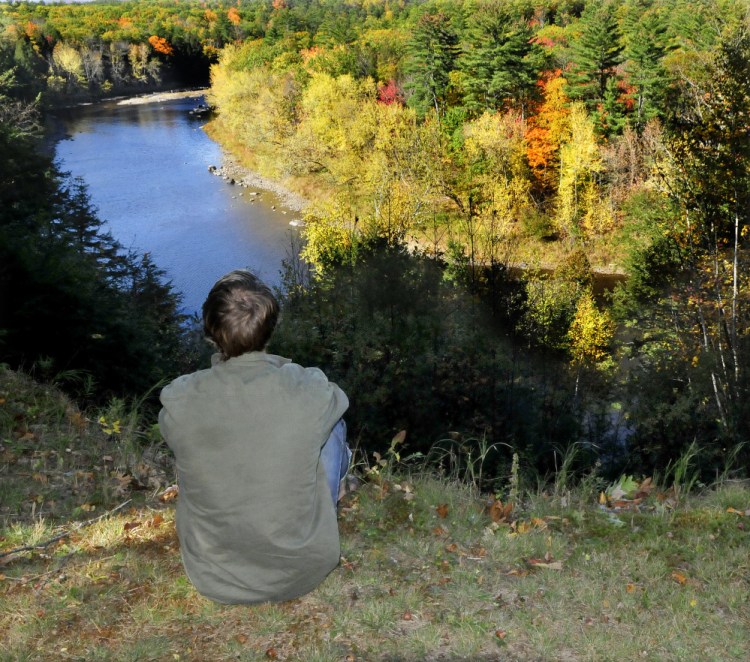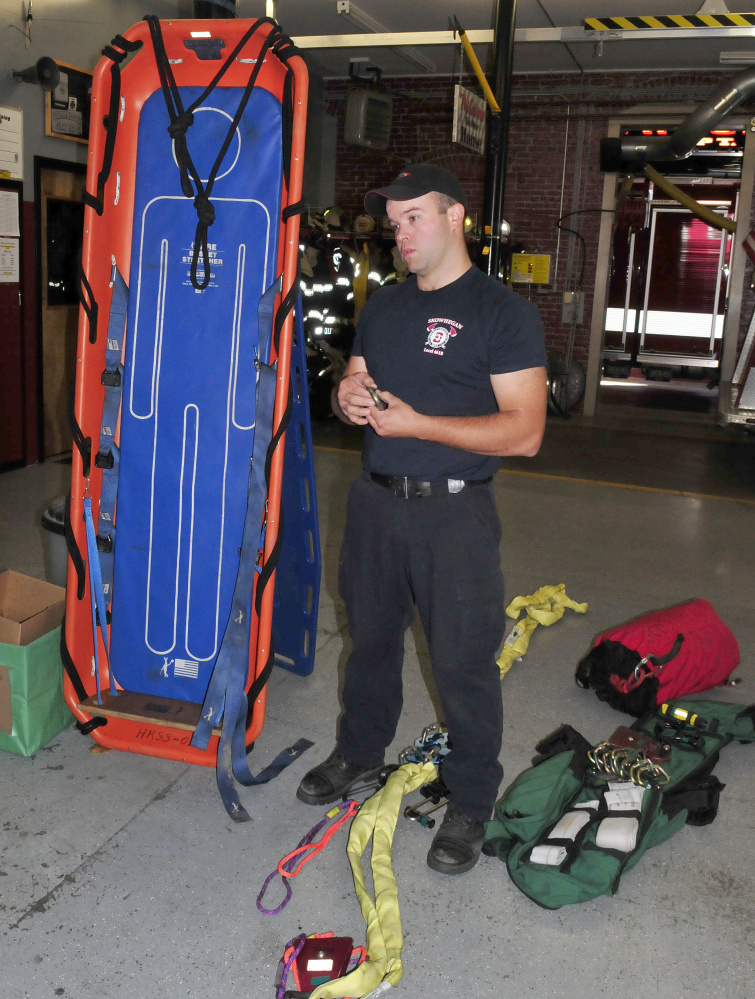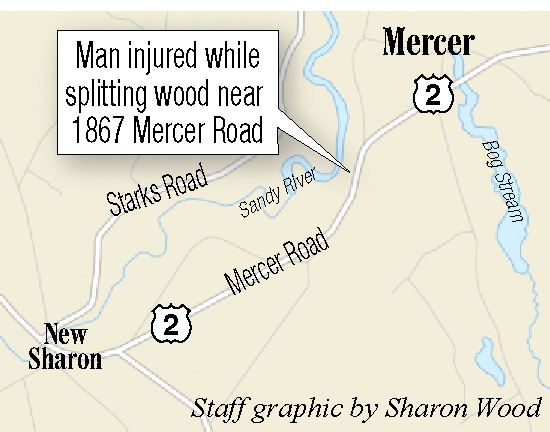MERCER — With the autumn-splashed Western Mountains in the distance, firefighters from Skowhegan and Norridgewock grappled with 300 feet of rope and a Stokes basket to hoist an injured man from the Sandy River to the top of a 260-foot, near-vertical embankment and an ambulance.
It was spectacular rescue Sunday afternoon in a spectacular location with the man’s life hanging in the balance.
The man, 25, had been chopping firewood, with his girlfriend and another friend, at a river beach near the base of the steep embankment when the ax he was wielding slipped, cutting him badly on the ankle.
The man, who declined to give his name Monday when approached for an interview, was bleeding heavily. The unusually steep incline deep in the woods made rescue difficult, even precarious, and led to the deployment of the Skowhegan Fire Department’s Technical Rescue Team to the accident off U.S. Route 2, Mercer Road.
But for the quick response of the firefighters and the “high angle” rescue, the accident could have been deadly.
The injured man was home Monday and agreed to be photographed from behind but did not want to recount the ordeal. He was still sore, but healing from the wound that Skowhegan Firefighter Scott Libby said he treated himself Sunday while waiting for help.
The man used his socks as a tourniquet to slow the bleeding, Libby said, then elevated his leg on nearby rocks to ease the blood flow, and was able to call for help.
The firefighters’ specialized training, advanced equipment, team work and good old fashioned manpower led to the rescue, Libby said. Rescue crews used pulleys and ropes attached to carabiner clips connected to a Stokes basket, a 7-foot long stretcher which holds the victim in place.
The man — along with firefighters attached to the rescue basket — were hauled to safety, one collective grunt at a time.
“It is labor intensive,” Libby said Monday at the fire station. “It was one of the more steeper embankments that we’ve dealt with. For the guys up top, it takes a lot of pulling. We pull 10, 20 feet of rope at a time, and it usually takes three or four firefighters to do that.”
EMS responded to the call at about 3:30 p.m. Sunday, Libby said. They assessed the situation and called Norridgewock Fire for assistance. Norridgewock then called Skowhegan for its Technical Rescue Team, which has the training and the equipment for a variety of dangerous rescues — high angle, low angle, water, trench and confined space rescue.
The combined Skowhegan and Norridgewock team worked with about 250 to 300 feet of rope using a Stokes basket to haul the man to the top where an EMS ambulance from Redington-Fairview General Hospital waited, Libby said. A total of 14 firefighters from both towns participated in the rescue.
The firefighters, Libby explained, attach themselves to the Stokes basket during the ascent to keep the basket from tipping as they are pulled with ropes and pulleys up the embankment by other members of the team.
From the time firefighters arrived on the river side, it took the crew about 30 minutes to get the victim to the top, Libby said.
“That was a good amount of time, we felt like, to get him up over the bank,” Libby said. “It was a half-hour of physical labor.”
The whole episode took about 45 minutes, including travel time from the Skowhegan fire station.
Added to the concerns involved in such a high-angle rescue is the safety of the rescuers, Libby said. They work in a variety of terrains and the focus is not to rush through a rescue. They must assess the scene as they go.
“Never just jump full throttle into it,” Libby said. “We don’t want to extend the scene any longer than we have to, but we’ve got to keep everybody safe that’s involved in the rescue.”
Skowhegan Fire Chief Shawn Howard said the Technical Rescue Team is one of only a handful in Maine. Department crews have special rescue training sessions six times every year in the various aspects of technical rescue.
The original High Angle Rescue Team was started in 1997 by then-Fire Chief Tom Keene, Howard said, and for confined space rescue, Skowhegan is the only one in the area. By Occupational Safety and Health Administration standards, a confined space is anywhere that someone can become trapped, such as a manhole with possible vapors or fumes and storage silos.
Sunday’s rescue was high angle — a steep, slippery ascent with an injured man on board.
“We were called because of the steep embankment and the height of the embankment to carry him up with our ropes,” Libby said. “He was the homeowner, and he has trails that he walks down in there to get to the river.”
But there were no trails to the accident site 100 yards into the woods and down the embankment to a raw, rocky drop off.
“In a remote setting you rely on good old fashioned manpower — brute strength,” Howard said.
“He seemed to be comfortable down there,” Libby said. “They had bleeding under control down there. Made him stable. He was talking with us the whole way.”
Doug Harlow — 612-2367
Twitter:@Doug_Harlow
Send questions/comments to the editors.






Success. Please wait for the page to reload. If the page does not reload within 5 seconds, please refresh the page.
Enter your email and password to access comments.
Hi, to comment on stories you must . This profile is in addition to your subscription and website login.
Already have a commenting profile? .
Invalid username/password.
Please check your email to confirm and complete your registration.
Only subscribers are eligible to post comments. Please subscribe or login first for digital access. Here’s why.
Use the form below to reset your password. When you've submitted your account email, we will send an email with a reset code.